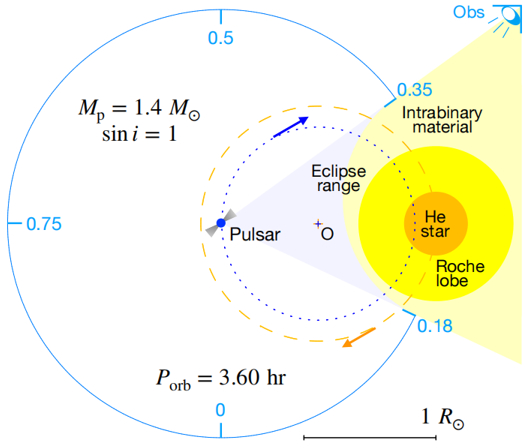Chinese scientists discovered a new type of pulsar binary system

Figure: Schematic diagram of the new binary star system composed of millisecond pulsars and helium stars discovered by FAST. The rotational period of a pulsar is 11.55 ms. The pulsar is eclipsed by the stellar wind of the companion star for 17% of the time when orbiting with it
Under the support of the National Natural Science Foundation of China (No. 12588202), a research team led by Research Professor HAN Jinlin from the National Astronomical Observatories of the Chinese Academy of Sciences, in collaboration with scholars from Qingdao Technological University, Nanjing University, Yunnan Astronomical Observatory, Sun Yat-sen University, Guangzhou University, Xinjiang Astronomical Observatory, Peking University and Southwest University, discovered a rare millisecond pulsar during the galactic plane pulsar survey using the Five-Hundred-meter Aperture Spherical radio Telescope (FAST). It orbits its companion star (a helium star) with a period of 3.6 hours, and is obscured by the winds of companion star for one-sixth of the orbit. Such a pulsar-helium star compact binary system should be the product formed by common envelope evolution. The results were published on May 23rd 2025 in the journal Science (https://www.science.org/doi/10.1126/science.ado0769 ).
In the vast Milky Way, most stars live in pairs and co-evolve in the form of binary star systems. Astronomers have a relatively clear understanding of how individual stars evolve, but how binary stars interact and evolve has been a cutting-edge conundrum in the field of astronomy for the past few decades. Evolution theory suggests that under specific conditions, the companion star of a neutron star will expand in volume due to mass loss, and even expand to the extent that it embraces the neutron star, evolving together in a shared hydrogen envelope for about a thousand years. During this process, the neutron star and its companion star keep approaching each other. The gravitational energy released from the binary orbit is enough to inject the shared hydrogen envelope completely within a thousand years, leaving only the burning cores of the companion star orbiting the neutron star in a very close orbit. The companion star becomes a helium-burning star, with a temperature of tens of thousands of degrees, called ‘helium stars’. However, such special binary star systems are extremely rare in the Milky Way and difficult to observe. There have been little evidence for the common envelope evolution of the binary systems.
The Five-hundred-meter Aperture Spherical Telescope (FAST) in China has an extremely high sensitivity and is a powerful tool for discovering pulsars. It is particularly sensitive for finding pulsars in extremely short-period orbits. In May 2020, when the research group led by HAN Jinlin conducted a deep search for pulsars in the Milky Way using FAST, they discovered a millisecond pulsar PSR J1928+1815 with a rotation period of 10.55 milliseconds. In November 2020, after several follow-up observations using FAST, it was confirmed and they found that it was in a compact orbit with a radius of only 500,000 kilometers, with an orbital period of only 3.6 hours. The pulsar is obscured by the companion star for approximately one sixth of the time. The mass of this companion star was estimated to be at least one solar mass, far exceeding the companion mass of typical spider pulsars. However, the compact orbit simply cannot accommodate a normal star like the Sun. Based on various limitations, it can be inferred that this companion star is neither an ordinary star nor a compact object after the normal stellar evolution, but rather a helium star that was formed through the common envelope evolution phase. Pulsar signal occultation is caused by the stellar wind material ejected by helium stars.
Discovery of this new type of binary pulsar provides a new observational basis for new projects in multiple fields such as the evolution of stellar populations, the prediction of gravitational wave sources, binary stars and stellar evolution processes, and helium star observations in depth optics/infrared, which have enabled astronomers to have a deeper understanding of the evolution of binary stars.
Contact Us

National Natural Science Foundation of China
Add: 83 Shuangqing Rd., Haidian District, Beijing, China
Postcode: 100085
Tel: 86-10-62327001
Fax: 86-10-62327004
E-mail: bic@nsfc.gov.cn
